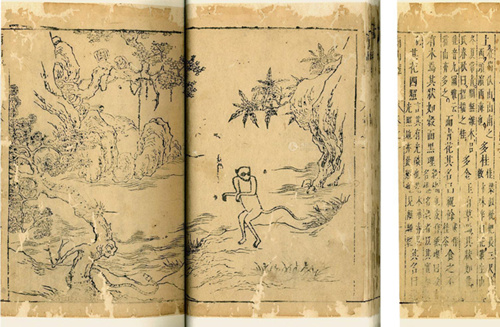
. > WHAT'S NEW > RESEARCH
Images crucial to historical research
Author : ZHANG JIE Source : Chinese Social Sciences Today 2017-07-26

The ancient book The Classic of Mountains and Rivers contains rich pictorial illustrations to aid storytelling.
Literary materials are not the only source for academic research. In addition to various other historical relics and artifacts, images have become a key source of historical information. As is the case with literary materials, images have provided an important way to analyze historical events.
Expanding sources
Throughout history, images have been used to communicate information. “Pictorial materials have been indispensable in Chinese historical research,” said Wu Qiong, dean of the Historical Images Studies Center at Beijing Normal University. The depiction of Chinese history began with images. Starting with river maps, ancient Chinese liked to use graphs. The pre-Qin book of mythology, The Classic of Mountains and Rivers, or Shanhaijing, has many images to aid storytelling. Most of the books written before the Xia Dynasty contained pictures. In addition, The General Annuals: Illustration of Images and Graphs written by Zheng Qiao in the Song Dynasty was a pioneer in using a combination of literary and pictorial materials in historical research, Wu said.
Ancient Chinese used the phrase “having maps on the left and history books on the right-a home library” to describe a rich store of books. This shows the close ties between pictorial and literary materials, which are mutually complementary in historical research, said Wang Yixin, a professor of history from Nankai University.
Maps were essential to the depiction of rivers, mountains and administrative regions in ancient China. Though there were many pictorial materials, traditional historical research relied mainly upon literary materials while images and graphs were only auxiliary. In modern times, innovations in printing techniques and the creation of photography increased the proportion of pictorial materials in historical research. Analysis, criticism, discrimination and use of these materials have become increasingly important, Wang said.
Complementary
Traditional literary materials record the name and process of historical events, not reflecting specific scenes or figures. Wang said pictorial historical materials are vivid and direct, which literal records cannot replace. “When you describe the environs and landforms around a river tribal site, a map, a planar graph or a profile map is much clearer than words; When you excavate an ancient tomb, the distribution of ruins and buried objects can be more clearly presented through photographs and schematic diagrams; When you write the cultural history of ancient society, a wall painting will be more vivid in revealing the social conditions and people’s daily lives.”
Though images and graphs more directly demonstrate history, their limitation are obvious. Wu pointed out that images contain rich historical information and also include complicated series of judgments. Images are designed and edited. Image recorders create their work with inherent subjectivity. It is necessary to acknowledge the technique and ideology behind the creation of each image before analyzing them.
“Without explanatory notes, images don’t make sense and subject to interpretation due to subjectivity and people’s imagination,” Wang said. Therefore, pictorial historical materials, though irreplaceable, cannot replace historical accounts. In addition, images might be abused by political propaganda, which should be avoided in particular, Wang added.
Discrimination
“Image history” aimed at research on images is about to emerge as a new discipline. Wang said scholars who are dedicated to the establishment of image history mostly confined the subject to historical geography and art history. Image history should extend to other sub-disciplines of history and form a theoretical basis.
Wu argued that historical images contain information that gives away the techniques used to create the images, which differentiates image history from traditional history. With the advancement and spread of digital video technology, images have played an increasingly significant role in recording and spreading history. The research and expression of historical questions are closely related to audiovisual technologies. The integration of traditional historical research and audiovisual technologies, together with the new historical narrative models and research paradigms that were consequently formed are issues that historians must take into account.
Wang suggested taking special notice of the limitations of image historical materials when using them. Literary records should still be the major resource for historical research. Interpretations of images are quite often subjective and imaginary. Without hard evidence, many interpretations are merely hypotheses. Historical research on prehistoric society, where there was no writing system, relies too much on excavated relics and image materials. Although they can, to some extent, give us new insight into life in ancient societies, they fail to accurately convey a specific historical event. In addition, image historical materials sometimes exaggerate or distort historical facts. Scholars should analyze these materials carefully before using them.
Ye Shengtao made Chinese fairy tales from a wilderness
Ye Shengtao (1894–1988) created the first collection of fairy tales in the history of Chinese children’s literature...
-
How northern ethnicities integrated into Chinese nation
2023-09-18
-
Mogao caves
2023-09-12
-
Mogao Grottoes as ‘a place of pilgrimage’
2023-09-12
-
Time-honored architectural traditions in China
2023-08-29
-
Disentangling the civilizational evolution of China
2023-08-28
-
AI ethics in science fiction
2023-08-23













 2011-2013 by www.cssn.cn. All Rights Reserved
2011-2013 by www.cssn.cn. All Rights Reserved